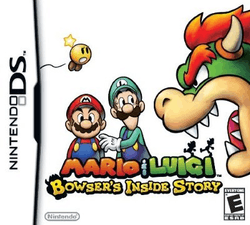
RPG-26
The RPG-26 Aglen is a disposable anti-tank rocket launcher developed by the Soviet Union. It fires a single-stage rocket with jack-knife fins, which unfold after launch. The rocket carries a 72.5 millimeter diameter high explosive anti-tank single shaped charge warhead capable of penetrating 440 millimeters of armour, one meter of reinforced concrete or one and a half meters of brickwork. It has a maximum effective range of around 250 meters.
A variant of the RPG-26, called the RShG-2, is armed with a thermobaric warhead. The RShG-2 is heavier than the RPG-26 at 3.5 kilograms, and has a reduced direct fire range of 115 meters. It is in service with the Russian Ground Forces.
Specifications
Operators
Current operators
Former operators
See also
External links
RPG
RPG may refer to:
In armed forces and military
In media and entertainment

Mario & Luigi: Bowser's Inside Story
Mario & Luigi: Bowser's Inside Story, known as Mario & Luigi RPG 3 (マリオ&ルイージRPG3! Mario ando Ruīji Āru Pī Jī Surī) in Japan, is a role-playing video game developed by AlphaDream and published by Nintendo for the Nintendo DS handheld game console in 2009. It is the third game in the Mario & Luigi series, following Mario & Luigi: Superstar Saga and Mario & Luigi: Partners in Time and preceding Mario & Luigi: Dream Team.
The game's plot involves Mario and Luigi being inhaled into the body of their long-time nemesis, Bowser. The Mario brothers learn to assist Bowser, who is unaware of their presence, as he combats Fawful, who has taken control of the Mushroom Kingdom. The gameplay focuses on the co-operation of the trio, who use their specific abilities to solve puzzles and fight enemies and thus progress through the game. Similar to its predecessors, its role-playing style emphasizes a turn-based battle system focused on timing accuracy, and is comedic in nature.

Mario & Luigi: Partners in Time
Mario & Luigi: Partners in Time, known in Japan as Mario & Luigi RPG 2×2 (マリオ&ルイージRPG2×2 Mario ando Ruīji Aru Pī Jī Tsū bai Tsū), is a role-playing video game developed by AlphaDream and published by Nintendo for the Nintendo DS handheld game console in 2005. It is the second game in the Mario & Luigi series, and is the sequel to Mario & Luigi: Superstar Saga for the Game Boy Advance. The game was followed by Mario & Luigi: Bowser's Inside Story, released in 2009.
Although the sequel to Superstar Saga, the game's plot is unrelated to that of its predecessor with an emphasis on the time-traveling theme, which involves the protagonists traveling between the past and present of the Mushroom Kingdom. The adventure follows Mario, Luigi, Baby Mario, and Baby Luigi as they search for Princess Peach, who has been abducted by an alien species known as the Shroobs. The gameplay centers on the co-operation between the quartet, who must use their specific qualities and skills to solve puzzles to progress through and features multiple role-playing game elements, but with a turn-based battle system focused on timing accuracy. The game is considerably darker in tone than its predecessor, especially in its plot and themes.
Podcasts:
Latest News for: rpg 26
Gonzaga transfer Jun Seok Yeo stays in WCC, signs with Seattle U
The Spokesman-Review 25 Apr 2025Duke basketball roster 2025-26: Cooper Flagg declares for NBA Draft, Isaiah Evans returns for next season
CBS Sports 23 Apr 2025Bethesda was right – Elder Scrolls fans wanted Oblivion Remastered, but I'm less sure about ...
Games Radar 23 Apr 2025Arkansas basketball roster 2025-26: Tracking who's in, out for John Calipari in Year 2 as ...
CBS Sports 22 Apr 2025Duke basketball roster 2025-26: Cooper Flagg declares for NBA Draft, joins Kon Knueppel by leaving early
CBS Sports 21 Apr 20252025 NBA Mock Draft: Cooper Flagg goes No. 1 to the Utah Jazz, two more ...
CBS Sports 21 Apr 2025Duke basketball roster 2025-26: Cooper Flagg's NBA decision looms as Tyrese Proctor declares for the ...
CBS Sports 19 Apr 2025Kentucky basketball roster 2025-26: Tracking who's in, who's out heading into Year 2 of the ...
CBS Sports 18 Apr 2025Duke basketball roster 2025-26: Cooper Flagg's NBA decision looms as Caleb Foster announces he's coming back
CBS Sports 18 Apr 2025Sullivan: Chicago Bulls fans still turning out \u2018through thick and thin.\u2019
Journal Gazette 18 Apr 2025Duke basketball roster 2025-26: Cooper Flagg's decision looms as Kon Knueppel declares for NBA Draft
CBS Sports 16 Apr 2025Duke basketball roster 2025-26: Cooper Flagg, Kon Knueppel NBA Draft decisions coming soon
CBS Sports 15 Apr 2025From Downtown: Meet the 2025 All-Big Bend Boys Basketball coach, Player of the Year
Tallahassee Democrat 14 Apr 2025Cowgirls signs 9 from SELA
American Press 14 Apr 2025- 1
- 2
- Next page »

